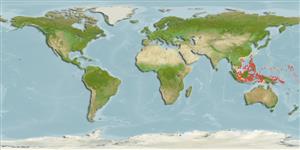Environment: milieu / climate zone / depth range / distribution range
Ekologi
laut berasosiasi dengan karang; kisaran kedalaman 1 - 30 m (Ref. 90102). Tropical; 30°N - 9°S
Western Pacific: Moluccas, Philippines, Ryukyu Islands, Palau, Yap, and Guam.
Size / Weight / umur
Maturity: Lm ? range ? - ? cm
Max length : 6.0 cm TL jantan/; (Ref. 48636)
Duri punggung (Keseluruhan (total)): 4; duri punggung lunak (Keseluruhan (total)): 8; Duri dubur 0; Sirip dubur lunak: 7. Identified by moderately long tentacle behind the eye and numerous small leafy appendages on the body (Ref. 48636).
Inhabits sand of shallow reefs, from tide pools to as deep as 30 m (Ref. 1602). Also inhabits sheltered reef lagoon habitats, usually in on algae reef near seagrass beds (Ref. 48636). Occurs solitary in weedy areas and sand-rubble bottoms (Ref. 90102).
Life cycle and mating behavior
Kematangan | Reproduksi, perkembang biakan | Pemijahan | telur-telur | Fecundity | Larva
Myers, R.F., 1991. Micronesian reef fishes. Second Ed. Coral Graphics, Barrigada, Guam. 298 p. (Ref. 1602)
Status IUCN Red List (Ref. 130435)
ancaman kepada manusia
Harmless
penggunaan manusia
informasi lanjut
Nama-nama umumSinonim (persamaan)metabolismePemangsaEkotoksikologiReproduksi, perkembang biakanKematanganPemijahanSpawning aggregationFecunditytelur-telurpekembangan telor
AcuanBudidaya airprofil budidaya airStrainGenetikaElectrophoresesDiturunkanPenyakit-penyakitPengolahanNutrientsMass conversion
mitraGambarStamps, Coins Misc.Suara-suaraCiguateraKecepatanTipe renangArea insangOtolithsOtakPenglihatan / visi
Alat, peralatan
laporan khas
muat turun XML
Sumber internet
Estimates based on models
Preferred temperature (Ref.
123201): 28 - 29.4, mean 28.9 °C (based on 931 cells).
Phylogenetic diversity index (Ref.
82804): PD
50 = 1.0000 [Uniqueness, from 0.5 = low to 2.0 = high].
Bayesian length-weight: a=0.00794 (0.00359 - 0.01758), b=2.80 (2.61 - 2.99), in cm total length, based on LWR estimates for this (Sub)family-body shape (Ref.
93245).
Trophic level (Ref.
69278): 2.9 ±0.25 se; based on food items.
Daya lenting (Ref.
120179): Tinggi, Waktu penggandaan populasi minimum kurang dari 15 bulan (Preliminary K or Fecundity.).
Fishing Vulnerability (Ref.
59153): Low vulnerability (10 of 100).
